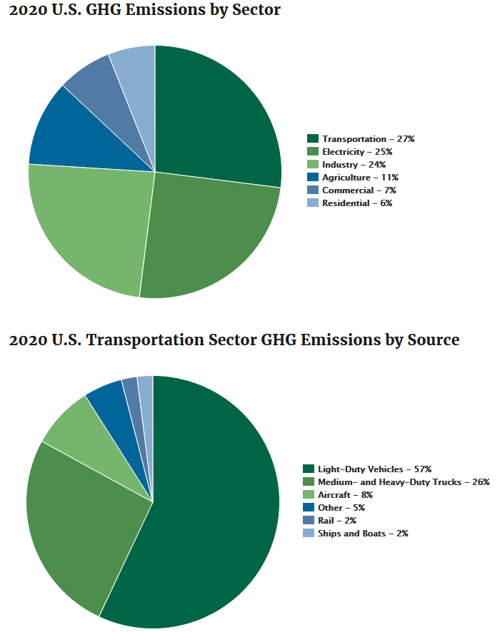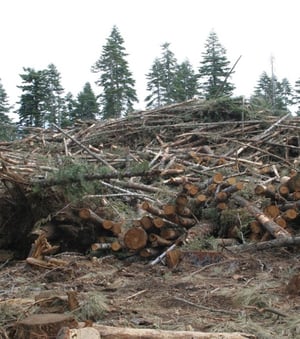5 min read
Sustainable Aviation Fuels: Frequently Asked Questions and Answers
John Greene
:
October 20, 2022

What is Sustainable Aviation Fuel (SAF)? SAF is a broad-based segment of biofuels used to power aircraft that has similar properties to conventional jet fuel, but with a smaller carbon footprint. Depending on the feedstock and technologies used to produce it, SAF can reduce lifecycle greenhouse gas (GHG) emissions dramatically compared to conventional jet fuel. SAF’s lower carbon intensity therefore makes it an important solution for reducing GHGs in the energy-intensive transportation sector.
What are the carbon emissions impacts from all sources in the transportation sector? The transportation sector is one of the largest contributors to GHG. Transportation accounted for the largest portion (27%) of total US GHG emissions in 2020, followed by electricity. Cars, trucks, commercial aircraft, and railroads, among other sources, all contribute to transportation sector GHG emissions.

Why target the aviation sector when the larger transportation/trucking sector is responsible for more carbon emissions? The aviation sector is under specific scrutiny for emissions reductions because it is extremely GHG intensive for the product sold:
- Aviation GHGs make up roughly 8% of US transportation GHG emissions, according to the S. Environmental Protection Agency.
- Aviation is a segment that is under specific scrutiny, as its impact is extremely intensive for the product sold: 1% of the planet’s population emit 50% of total aviation GHG.
How large is the market for SAF? Currently, there are roughly 300 million gallons of SAF used worldwide. To put that number in perspective compared to demand for other popular fuels, the US alone currently use ~23 billion gallons of aviation fuel per year. In addition, the US uses roughly:
- 123 billion gallons of gasoline
- 64 billion gallons of diesel
- 15 billion gallons of ethanol
- 4 billion gallons of biodiesel/renewable diesel
What makes SAF sustainable compared to existing aviation fuels? Environmental scientists, including scientists at the National Council on Air and Stream Improvements (NCASI), recognize the difference between biogenic and non-biogenic sources of energy – including aviation fuels. Combusting fossil (non-biogenic or below ground) sources of carbon (coal, oil, natural gas) adds to the carbon dioxide content of the atmosphere because these resources are “captured” and released from within the earth.
Combusting renewable (biogenic or above ground) sources of carbon, however, adds little to no net carbon dioxide to the atmosphere when considered over the long-term. In the case of woody biomass as a feedstock for SAF, for instance, as long as forest inventories are not being depleted, this biogenic carbon is reabsorbed by new plant life as it grows. It is a renewable and therefore a “sustainable” cyclical process.
What renewable resources can be used to produce SAF? There are a number of readily available and renewable resources that can be used to produce SAF, including:
- Corn grain
- Oil seeds
- Algae
- Other fats, oils, and greases
- Agricultural residues
- Forestry residues
- Wood mill waste
- Municipal solid waste streams
- Wet wastes (manures, wastewater treatment sludge)
- Dedicated energy crops
How much renewable material is available? An estimated 1 billion dry tons of biomass can be collected sustainably each year in the United States, which is enough to produce 50–60 billion gallons of low-carbon biofuels that can be utilized across all transportation sectors. Looking at two biogenic waste streams as an example, the US produces corn on about 90 million acres of land per year, which generates 3-4 tons per acre of corn stover (waste), which can be used to produce biofuel. Forest biomass can be harvested from roughly 300 million acres while generating 1-2 tons per acre of residue material that can be used as a feedstock.
Is SAF more expensive than conventional aviation fuels? The average worldwide price of jet fuel is about $3.70 per gallon—roughly 65% higher than a year ago, according to the International Air Transport Association (IATA). Low-carbon SAF is approximately 2-4 times more expensive to manufacture than conventional jet fuels. For most airlines, fuel accounts for about 20 - 30% of operational costs, so current SAF prices add significant cost for airlines.
Does the Inflation Reduction Act (IRA) support the development and growth of SAF and other biofuels? The most noteworthy development in the IRA allows for an income tax credit for blending SAF into regular jet fuels in US airports, which enables airlines to claim tax credits parallel to the other road transportation fuel companies, users, and blenders of fuels. To achieve this, the bill includes two important incentives for SAF producers:
- The first is a $1.25 per-gallon credit available for each gallon of SAF sold as part of a qualified fuel mixture if the SAF has a demonstrated lifecycle GHG reduction of at least 50% compared to conventional jet fuel. The credit increases to a maximum of $1.75 per gallon in one cent per-gallon increments based upon the performance of the feedstocks and processing towards lowering the Carbon Intensity (CI) of the fuel.
- The second, which begins in 2025, is a tax credit for producers of general low-carbon fuels that can be used in aviation. This credit also will offer a $1.75 a gallon rebate for a 100% emissions reduction compared with fossil fuels.
However, the first credit will be available in 2023 and expires at the end of 2024, and the fuel must be produced in the USA and not imported. The second credit takes effect in 2025 and expires at the end of 2027, which doesn’t provide much time to get a successful project off the ground.
Are any major airlines already using, or committed to using SAF in the future? Several airlines have signed agreements to purchase SAF in large quantities. Recent notable announcements include United, Alaska and Southwest. Although terms of the announcements are generally not published, our analysis suggests that SAF must eventually to be cost-competitive with fossil fuel adjusted for carbon costs. Non-aviation companies are also piloting SAF purchase agreements to reduce their emissions: Deloitte has purchased 630,000 gallons worth of SAF commitments, for example.
Will SAF made from woody biomass cause deforestation? In many markets, the largest single source of renewable energy is found in sustainable biomass, which is a cornerstone of many low-carbon energy transitions. For the last decade, forest resources in the US South have helped to meet the European Union’s renewable and climate goals that include:
- Reducing greenhouse gas emissions by 55% from 1990 levels
- Decreasing consumption of coal by 70% and gas by 25% from 2015 levels
- Increasing the share of renewable energy to 38-40%
This heavily forested region exported over 7 million metric tons of sustainable woody biomass to the EU and UK in 2021, and it has the capacity to sustainably increase its production to 35 million metric tons.
There are five important principles to help understand what constitutes sustainable biomass, how it supports forest growth in the US South, and how it can contribute to achieving meaningful climate goals.
- Sustainable biomass is sourced from forests where forest inventory and carbon stocks are stable or increasing. Steady increases in forest inventory mean emissions from biomass are quickly sequestered by the continually growing forest landscape from which it is sourced.
- In the US, sustainable biomass represents a tiny fraction of the forest products industry. Each year, only 4% of the forest is harvested in this region leaving the remaining 96% to keep growing. Of that 4% that is harvested, just 3% is used for biomass.
- Forests tracts in the US Southeast are not clear-cut exclusively for biomass. Wood from a single tract of land typically supplies multiple markets, including sawmills, solid wood products, pulp and paper, and bioenergy, among others.
- Sustainable biomass is produced from low-value wood that is created as a by-product of a traditional timber harvest. Forest tracts are typically managed for high-value sawtimber, which generate the most revenue for landowners. Some trees that do not meet the specifications for sawtimber are cascaded for use as biomass, which is in keeping with the principle of using wood fiber for its greatest climate benefit.
- Biomass is a small market but helps forest owners keep planting trees. Private citizens own 86% of the forestland in the US Southeast. Strong demand for forest products, like biomass, incentivize landowners to continue the cycle of planting and harvesting, versus converting their forestland to other, more lucrative uses. This demand helps landowners preserve and manage their forest to promote wildlife and biodiversity in the region.





